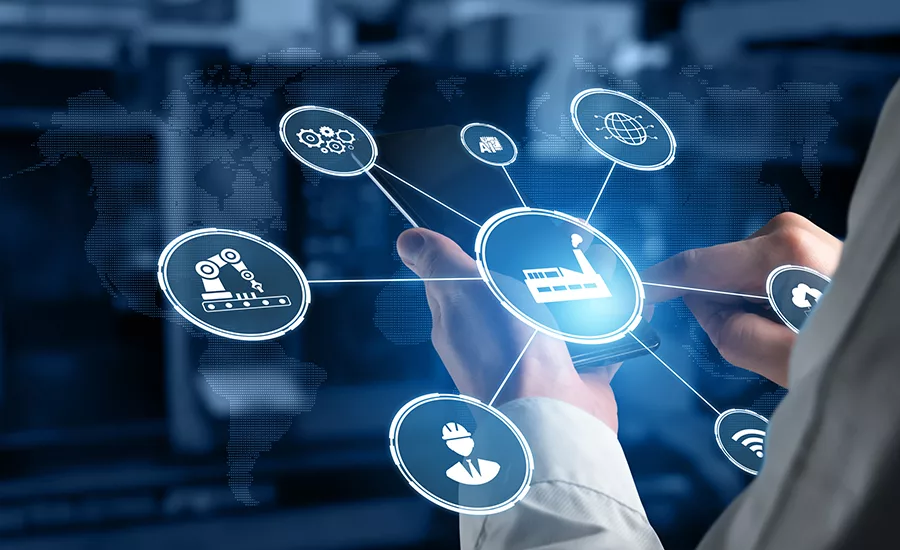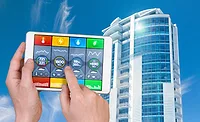Smart Building Trends to Watch

Blue Planet Studio/iStock / Getty Images Plus via Getty Images
At the recent Securing New Ground conference, held virtually October 28, the topic of smart buildings came up multiple times — particularly in regards to new technology trends, pandemic impacts as well as cybersecurity concerns and the differences between IT/OT.
During an interactive SIA Megatrends session designed to get attendees input on top trends to watch in 2022, Brivo President and CEO Steve Van Till asked a series of questions ranging from the current most and least impactful trends to what will be the most important in the next two years. Artificial intelligence topped the list of most impactful (followed by cloud computing), while “responsive environment and intelligent spaces” was deemed least impactful. But that doesn’t mean smart buildings are less important today. Instead, they are shifting priorities. For example, more than three quarters of respondents answered that it was either extremely or very likely that predictive data analytics will become a meaningful feature within your products, software or solutions within the next two years.
These points were echoed by presenters across several sessions.
“These are unprecedented times, not just because of the pandemic but our customer’s needs are moving at a rapid pace,” said Bhuvana Badrinathan, CIO of Convergint. “They want to move to cloud-based solutions and there has been an increase in disruptive technologies like AI. Businesses are prioritizing digital transformation initiatives and we have developed solutions tailored to specific needs of customers.”
The Evolving Meaning of ‘Smart’
While smart buildings have been around a while, the pandemic has caused some end users to rethink what they want in a ‘smart’ building. Previously smart buildings often meant energy efficient, frictionless security and convenience. Today’s smart buildings need to include health considerations as well.
“As people started to bring occupants back into buildings they were queuing them up differently,” said Joe Hudock, senior vice president, marketing and sales excellence, for dormakaba USA. “Where and when they came into the building was becoming congested and the dynamics were thrown off because the flow of people had changed.”
For example, the doors staying open longer due to lines created by new protocols impacted the energy efficiency, he explained. “Smart buildings moving forward will need to take into account who should be in at what times, the number of people in the building, energy management and air quality.”
In order to accomplish this, providers of smart building solutions need to shift their mindset, as well as their planning.
“We are being pulled forward by the nature of what we are facing, Hudock said. “It does challenge us to think about what is a smart building, the safety component changing to include health and how you move people around based on their credentialing.”
Peter Boriskin, CTO-Americas for ASSA ABLOY added there are two distinct aspects to planning for this. The first is workflow and how to manage people and access control to know who is going where, when. The second is the health and safety of the products themselves.
“We are being asked a lot about transparency. When you talk about safety and health, the products themselves also need to meet those requirements. If I am touching something like a handle or a lock, is it being plated in a way that might be harmful down the road? The things we are producing, are they healthy? We are starting to see areas of concern we never thought about before.”
Expanding the Definition of ‘Secure’
From smart to healthy, the other side of the smart building discussion becomes is it secure both physically and cyber-wise? This is increasingly critical as OT systems are coming under attack for themselves, not just as a portal to something else.
“What has to take place to raise it from a dumb building to a smart one? That is where cyber comes in,” said Adam Chapman, cybersecurity manager and product and solution security officer for Siemens. “We are seeing a change in the attacker landscape and a shift in interest in the OT space as a target, not just a pass-through. Historically on the IT side they were attacking information. On the OT side they are looking at operations-focused attacks like knocking it offline or turning the temperature up or down, opening or closing a door.”
OT used to be more resistant to these attacks because the networks were isolated. Smart buildings changed that with more and more connected sensors and devices. Now operational attacks are some of the leading types of attacks, he said.
“Healthy buildings are something attackers would like to attack,” Chapman said. “These are the fundamental challenges of our industry. As the attacker landscape and connectivity landscape converge, with the same attackers attacking both systems, we have to take lessons from the IT world.”
The problem is OT devices — unlike IT devices — have a much longer lifecycle, up to 20 years in some cases. “The compute power in the average OT device is a fraction of what you have in the IT world and that is really the core of our challenge as an industry: How to pick and choose the best things of the IT industry and meld it into something that works in the OT space,” Chapman said. “We need the building to remain both safe and operational. We can’t ignore that or we will only have a nice building for a couple of weeks and then it will be offline for a month.”
The key is wherever possible to design these buildings for all of these factors from the start.
“A smart building needs to be a smart and secure, and smart and connected building, Chapman said. “It takes a mindset shift.”
Looking for a reprint of this article?
From high-res PDFs to custom plaques, order your copy today!







